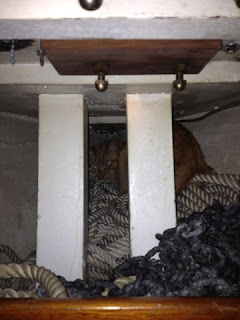As you might imagine, we're off the boat for a few days and with our families for the holidays. I thought I might post an update, though. Taylor and his wonderful mother, Janice, have set out to stitch the drogue together today and make some storage pockets (and perhaps some chalk bags for climbing) out of an old colorful sail I found at the dumpster. My holiday assignment is to place orders for some parts and study for the Ham radio license test. Dana put in a hard day's work in the aft quarter yesterday. And Anna was able to finish the lettering on the transom before heading back to Seattle earlier this week. Productivity remains high and the excitement is building!
We chose as a re-christening ceremony to pour a bottle of rum in our water tank and have ourselves a little shindig at the dock. We managed to roast 8 pounds of pork ribs dockside for four and a half hours pretty much to perfection. Dana (la cabra de la barca) handled the cooking and, with the help of dear old friends Shane, John, Candice, Zac and Charlie, we managed to put back a respectable number of beers in the mean time.
Our pre-Mexico list is getting pretty short. The solar panels arrived so our top priority is installing those and building shelves in the aft quarter for jerry cans. Incidentally, we were able to cut up Clint's old stern pulpit and are going to incorporate all four stanchions into Ardea. Two will go to stabilize the rails holding the solar panels and two will comprise the aft-most support for the jerry can shelves. We (mainly I) get a fair amount of grief for regularly acquiring parts and materials via dumpster diving, but I swear it pays off!
 |
| Shane, back from DR, built a glorious shelf in the propane housing and helped us find a home for more than a couple beers. |
After the panels are up and jerry cans shelved, we'll service the engine and start to stock all of our spares. We're not ones to spare on frivolities though and I imagine we'll have a bit of a slow down next week due to celebrations: Dana is headed to Bodega Bay with his family and Taylor, Anna and I are all going to be in Tahoe for three days for music (Another music festival?!? Yes.). We've got a couple days to work on the boat this week and then we're really on the home stretch come the New Year. We may be pushing off for Mexico sooner than planned, but only time will tell.
Our happiest holiday wishes to all.
Connor







































